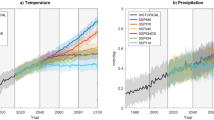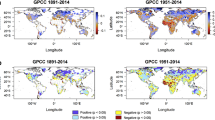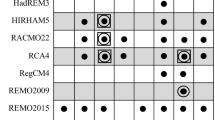Abstract
Based on the outputs of 30 models from Coupled Model Intercomparison Project Phase 5 (CMIP5), the fractional changes in the amplitude interannual variability (σ) for precipitation (P′) and vertical velocity (ω′) are assessed, and simple theoretical models are constructed to quantitatively understand the changes in σ(P′) and σ(ω′). Both RCP8.5 and RCP4.5 scenarios show similar results in term of the fractional change per degree of warming, with slightly lower inter-model uncertainty under RCP8.5. Based on the multi-model median, σ(P′) generally increases but σ(ω′) generally decreases under global warming but both are characterized by non-uniform spatial patterns. The σ(P′) decrease over subtropical subsidence regions but increase elsewhere, with a regional averaged value of 1.4% K− 1 over 20°S–50°N under RCP8.5. Diagnoses show that the mechanisms for the change in σ(P′) are different for climatological ascending and descending regions. Over ascending regions, the increase of mean state specific humidity contributes to a general increase of σ(P′) but the change of σ(ω′) dominates its spatial pattern and inter-model uncertainty. But over descending regions, the change of σ(P′) and its inter-model uncertainty are constrained by the change of mean state precipitation. The σ(ω′) is projected to be weakened almost everywhere except over equatorial Pacific, with a regional averaged fractional change of − 3.4% K− 1 at 500 hPa. The overall reduction of σ(ω′) results from the increased mean state static stability, while the substantially increased σ(ω′) at the mid-upper troposphere over equatorial Pacific and the inter-model uncertainty of the changes in σ(ω′) are dominated by the change in the interannual variability of diabatic heating.













Similar content being viewed by others
References
Adler RF, Huffman GJ, Chang A, Ferraro R, Xie PP, Janowiak J, Rudolf B, Schneider U, Curtis S, Bolvin D, Gruber A, Susskind J, Arkin P, Nelkin E (2003) The version-2 global precipitation climatology project (GPCP) monthly precipitation analysis (1979-present). J Hydrometeorol 4(6):1147–1167. https://doi.org/10.1175/1525-7541(2003)004%3C1147:tvgpcp%3E2.0.co;2
Bonfils CJW, Santer BD, Phillips TJ, Marvel K, Leung LR, Doutriaux C, Capotondi A (2015) Relative contributions of mean-state shifts and ENSO-driven variability to precipitation changes in a warming climate. J Clim 28(24):9997–10013. https://doi.org/10.1175/jcli-d-15-0341.1
Brown PT, Caldeira K (2017) Greater future global warming inferred from Earth’s recent energy budget. Nature 552:45. https://doi.org/10.1038/nature24672
Cai W, Borlace S, Lengaigne M, van Rensch P, Collins M, Vecchi G, Timmermann A, Santoso A, McPhaden MJ, Wu L, England MH, Wang G, Guilyardi E, Jin F-F (2014) Increasing frequency of extreme El Nino events due to greenhouse warming. Nature Clim Change 4(2):111–116. https://doi.org/10.1038/nclimate2100
Chen J, Bordoni S (2016) Early summer response of the East Asian summer monsoon to atmospheric CO2 forcing and subsequent sea surface warming. J Clim 29(15):5431–5446. https://doi.org/10.1175/JCLI-D-15-0649.1
Chen W, Lee J-Y, Ha K-J, Yun K-S, Lu R (2016) Intensification of the Western North Pacific anticyclone response to the short decaying El Niño event due to greenhouse warming. J Clim 29(10):3607–3627. https://doi.org/10.1175/jcli-d-15-0195.1
Chen J, Wen Z, Wu R, Wang X, He C, Chen Z (2017) An interdecadal change in the intensity of interannual variability in summer rainfall over southern China around early 1990s. Clim Dyn 48(1):191–207. https://doi.org/10.1007/s00382-016-3069-8
Chou C, Neelin JD, Chen C-A, Tu J-Y (2009) Evaluating the “Rich-Get-Richer” mechanism in tropical precipitation change under global warming. J Clim 22(8):1982–2005. https://doi.org/10.1175/2008jcli2471.1
Chung CTY, Power SB (2016) Modelled impact of global warming on ENSO-driven precipitation changes in the tropical Pacific. Clim Dyn 47(3):1303–1323. https://doi.org/10.1007/s00382-015-2902-9
Collins M, An S-I, Cai W, Ganachaud A, Guilyardi E, Jin F-F, Jochum M, Lengaigne M, Power S, Timmermann A, Vecchi G, Wittenberg A (2010) The impact of global warming on the tropical Pacific Ocean and El Nino. Nature Geosci 3(6):391–397
Collins M, KAchutaRao K, Ashok K, Bhandari S, Mitra AK, Prakash S, Srivastava R, Turner A (2013) Observational challenges in evaluating climate models. Nat Clim Chang 3:940–941
Dai A, Wigley TML (2000) Global patterns of ENSO-induced precipitation. Geophys Res Lett 27(9):1283–1286. https://doi.org/10.1029/1999gl011140
Dee DP, Uppala SM, Simmons AJ et al (2011) The ERA-Interim reanalysis: configuration and performance of the data assimilation system. Q J Roy Meteor Soc 137(656):553–597. https://doi.org/10.1002/qj.828
Ding YH (2007) The variability of the Asian summer monsoon. J Meteorol Soc Jpn 85B:21–54
Deser C, Phillips A, Bourdette V, Teng H (2010) Uncertainty in climate change projections: the role of internal variability. Clim Dynam 38(3–4):527–546. https://doi.org/10.1007/s00382-010-0977-x
Donat MG, Lowry AL, Alexander LV, O’Gorman PA, Maher N (2016) More extreme precipitation in the world’s dry and wet regions. Nat Clim Chang 6:508. https://doi.org/10.1038/nclimate2941
Fan K, Xu Z, Tian B (2014) Has the intensity of the interannual variability in summer rainfall over South China remarkably increased? Meteorol Atmos Phys 124(1–2):23–32. https://doi.org/10.1007/s00703-013-0301-5
Ferguson IM, Dracup JA, Duffy PB, Pegion P, Schubert S (2010) Influence of SST Forcing on Stochastic Characteristics of Simulated Precipitation and Drought. J Hydrometeorol 11(3):754–769. https://doi.org/10.1175/2009jhm1132.1
Fischer EM, Rajczak J, Schär C (2012) Changes in European summer temperature variability revisited. Geophys Res Lett 39 (19). doi:https://doi.org/10.1029/2012GL052730
Fu Y (2012) The projected temporal evolution in the interannual variability of East Asian summer rainfall by CMIP3 coupled models. Sci China Earth Sci 56(8):1434–1446. https://doi.org/10.1007/s11430-012-4430-3
Gleckler PJ, Taylor KE, Doutriaux C (2008) Performance metrics for climate models. J Geophys Res: Atmos 113(D6):D06104. https://doi.org/10.1029/2007jd008972
Guan Z, Yamagata T (2003) The unusual summer of 1994 in East Asia: IOD teleconnections. Geophys Res Lett. https://doi.org/10.1029/2002GL016831
Guo Y, Zhao Y, Wang J (2002) Numerical simulation of the relationships between the 1998 yangtze river valley floods and SST anomalies. Adv Atmos Sci 19(3):391–404. https://doi.org/10.1007/s00376-002-0074-0
He J, Soden BJ (2017) A re-examination of the projected subtropical precipitation decline. Nature Clim Change 7(1):53–57. https://doi.org/10.1038/nclimate3157
He C, Zhou T, Lin A, Wu B, Gu D, Li C, Zheng B (2015) Enhanced or weakened Western North Pacific subtropical high under global warming? Sci Reports 5:16771. https://doi.org/10.1038/srep16771
He C, Lin A, Gu D, Li C, Zheng B (2017a) Formation mechanism for the amplitude of interannual climate variability in subtropical northern hemisphere: relative contributions from the zonal asymmetric mean state and the interannual variability of SST. Clim Dyn 48(1):697–705. https://doi.org/10.1007/s00382-016-3105-8
He C, Wu B, Zou L, Zhou T (2017b) Responses of the summertime subtropical anticyclones to global warming. J Clim 30(16):6465–6479. https://doi.org/10.1175/jcli-d-16-0529.1
Held IM, Soden BJ (2006) Robust responses of the hydrological cycle to global warming. J Clim 19(21):5686–5699. https://doi.org/10.1175/jcli3990.1
Holmes CR, Woollings T, Hawkins E, de Vries H (2016) Robust future changes in temperature variability under greenhouse gas forcing and the relationship with thermal advection. J Clim 29(6):2221–2236. https://doi.org/10.1175/jcli-d-14-00735.1
Hsu H-H, Liu X (2003) Relationship between the Tibetan Plateau heating and East Asian summer monsoon rainfall. Geophys Res Lett. https://doi.org/10.1029/2003gl017909
Hu K, Huang G, Zheng X-T, Xie S-P, Qu X, Du Y, Liu L (2014) Interdecadal variations in ENSO influences on Northwest Pacific–East Asian early summertime climate simulated in CMIP5 models. J Clim 27(15):5982–5998. https://doi.org/10.1175/jcli-d-13-00268.1
Hu X, Cai M, Yang S, Wu Z (2017) Delineation of thermodynamic and dynamic responses to sea surface temperature forcing associated with El Niño. Clim Dyn. https://doi.org/10.1007/s00382-017-3711-0
Huang P, Xie S-P (2015) Mechanisms of change in ENSO-induced tropical Pacific rainfall variability in a warming climate. Nature Geosci. https://doi.org/10.1038/ngeo2571
Huang Y, Li X, Wang H (2016) Will the western Pacific subtropical high constantly intensify in the future? Clim Dyn 47(1–2):567–577. https://doi.org/10.1007/s00382-015-2856-y
Huang P, Chen D, Ying J (2017) Weakening of the tropical atmospheric circulation response to local sea surface temperature anomalies under global warming. J Clim 30(20):8149–8158. https://doi.org/10.1175/jcli-d-17-0171.1
Kanamitsu M, Ebisuzaki W, Woollen J, Yang SK, Hnilo JJ, Fiorino M, Potter GL (2002) NCEP-DOE AMIP-II reanalysis (R-2). Bull Am Meteorol Soc 83(11):1631–1643. https://doi.org/10.1175/bams-83-11-1631
Knutson TR, Manabe S (1995) Time-mean response over the tropical Pacific to increased CO2 in a coupled Ocean-Atmosphere model. J Clim 8(9):2181–2199. https://doi.org/10.1175/1520-0442(1995)008%3C2181:tmrott%3E2.0.co;2
Knutson TR, McBride JL, Chan J, Emanuel K, Holland G, Landsea C, Held I, Kossin JP, Srivastava AK, Sugi M (2010) Tropical cyclones and climate change. Nat Geosci 3:157. https://doi.org/10.1038/ngeo779
Kummu M, Gerten D, Heinke J, Konzmann M, Varis O (2014) Climate-driven interannual variability of water scarcity in food production potential: a global analysis. Hydrol Earth Syst Sci 18(2):447–461. https://doi.org/10.5194/hess-18-447-2014
Lee D-K, Cha D-H, Kang H-S (2004) Regional climate simulation of the 1998 summer flood over East Asia. J Meteorol Soc Jpn 82(6):1735–1753. https://doi.org/10.2151/jmsj.82.1735
Lee J-Y, Wang B, Seo K-H, Kug J-S, Choi Y-S, Kosaka Y, Ha K-J (2014) Future change of Northern hemisphere summer tropical–extratropical teleconnection in CMIP5 models. J Clim 27(10):3643–3664. https://doi.org/10.1175/jcli-d-13-00261.1
Leonardo N, Hameed S (2015) Impact of the Hawaiian high on interannual variations of winter precipitation over California. J Clim 28(14):5667–5682. https://doi.org/10.1175/jcli-d-14-00518.1
Li W, Li L, Ting M, Liu Y (2012) Intensification of Northern hemisphere subtropical highs in a warming climate. Nat Geosci 5(11):830–834. https://doi.org/10.1038/ngeo1590
Li L, Li W, Barros AP (2013) Atmospheric moisture budget and its regulation of the summer precipitation variability over the Southeastern United States. Clim Dyn 41(3):613–631. https://doi.org/10.1007/s00382-013-1697-9
Li T, Zhang L, Murakami H (2015) Strengthening of the Walker circulation under globalwarming in an aqua-planet general circulation model simulation. Adv Atmos Sci 32(11):1473–1480. https://doi.org/10.1007/s00376-015-5033-7
Li G, Xie S-P, Du Y, Luo Y (2016) Effects of excessive equatorial cold tongue bias on the projections of tropical Pacific climate change. Part I: the warming pattern in CMIP5 multi-model ensemble. Clim Dyn 47(12):3817–3831. https://doi.org/10.1007/s00382-016-3043-5
Li G, Xie S-P, He C, Chen Z (2017) Western Pacific emergent constraint lowers projected increase in Indian summer monsoon rainfall. Nature Clim Change 7(10):708–712. https://doi.org/10.1038/nclimate3387
Lin R, Zhou T, Qian Y (2014) Evaluation of global monsoon precipitation changes based on five reanalysis datasets. J Clim 27(3):1271–1289. https://doi.org/10.1175/jcli-d-13-00215.1
Liu YM, Wu GX, Ren RC (2004) Relationship between the subtropical anticyclone and diabatic heating. J Clim 17(4):682–698
Liu R, Liu SC, Shiu C-J, Li J, Zhang Y (2016) Trends of regional precipitation and their control mechanisms during 1979–2013. Adv Atmos Sci 33(2):164–174. https://doi.org/10.1007/s00376-015-5117-4
Long S-M, Xie S-P, Liu W (2016) Uncertainty in tropical rainfall projections: atmospheric circulation effect and the ocean coupling. J Clim 29(7):2671–2687. https://doi.org/10.1175/JCLI-D-15-0601.1 doi
Lu R, Fu Y (2010) Intensification of East Asian summer rainfall interannual variability in the twenty-first century simulated by 12 CMIP3 coupled models. J Clim 23(12):3316–3331. https://doi.org/10.1175/2009jcli3130.1
Ma J, Xie S-P, Kosaka Y (2012) Mechanisms for tropical tropospheric circulation change in response to global warming. J Clim 25(8):2979–2994. https://doi.org/10.1175/jcli-d-11-00048.1
Mearns LO, Rosenzweig C, Goldberg R (1992) Effect of changes in interannual climatic variability on CERES-wheat yields: sensitivity and 2 × CO2 general circulation model studies. Agric For Meteorol 62(3):159–189. https://doi.org/10.1016/0168-1923(92)90013-T
Menon A, Levermann A, Schewe J (2013) Enhanced future variability during India’s rainy season. Geophys Res Lett 40(12):3242–3247. https://doi.org/10.1002/grl.50583
Park C-K, Schubert SD (1997) On the nature of the 1994 East Asian summer drought. J Clim 10(5):1056–1070. https://doi.org/10.1175/1520-0442(1997)010%3C1056:otnote%3E2.0.co;2
Park D-SR, Ho C-H, Chan JCL, Ha K-J, Kim H-S, Kim J, Kim J-H (2017) Asymmetric response of tropical cyclone activity to global warming over the North Atlantic and western North Pacific from CMIP5 model projections. Sci Reports 7:41354. https://doi.org/10.1038/srep41354
Pendergrass AG, Gerber EP (2016) The rain is askew: two idealized models relating vertical velocity and precipitation distributions in a warming world. J Clim 29(18):6445–6462. https://doi.org/10.1175/jcli-d-16-0097.1
Pendergrass AG, Knutti R, Lehner F, Deser C, Sanderson BM (2017) Precipitation variability increases in a warmer climate. Sci Reports 7(1):17966. https://doi.org/10.1038/s41598-017-17966-y
Perkins-Kirkpatrick SE, Gibson PB (2017) Changes in regional heatwave characteristics as a function of increasing global temperature. Sci Reports 7(1):12256. https://doi.org/10.1038/s41598-017-12520-2
Pfahl S, O’Gorman PA, Fischer EM (2017) Understanding the regional pattern of projected future changes in extreme precipitation. Nat Clim Chang 7:423. https://doi.org/10.1038/nclimate3287
Power SB, Delage F, Colman R, Moise A (2012) Consensus on twenty-first-century rainfall projections in climate models more widespread than previously thought. J Clim 25(11):3792–3809. https://doi.org/10.1175/jcli-d-11-00354.1
Qu X, Huang G (2016) The global warming–induced South Asian high change and its uncertainty. J Clim 29(6):2259–2273. https://doi.org/10.1175/JCLI-D-15-0638.1 doi
Rodwell MJ, Hoskins BJ (2001) Subtropical anticyclones and summer monsoons. J Clim 14(15):3192–3211. https://doi.org/10.1175/1520-0442(2001)014%3C3192:saasm%3E2.0.co;2
Schneider T, O’Gorman PA, Levine XJ (2010) Water Vapor and the dynamics of climate changes. Rev Geophys 48(3):RG3001. https://doi.org/10.1029/2009rg000302
Seager R, Naik N, Vecchi GA (2010) Thermodynamic and dynamic mechanisms for large-scale changes in the hydrological cycle in response to global warming. J Clim 23(17):4651–4668. https://doi.org/10.1175/2010jcli3655.1
Seager R, Naik N, Vogel L (2012) Does global warming cause intensified interannual hydroclimate variability? J Clim 25(9):3355–3372. https://doi.org/10.1175/jcli-d-11-00363.1
Simon Wang SY, Huang W-R, Hsu H-H, Gillies RR (2015) Role of the strengthened El Niño teleconnection in the May 2015 floods over the southern Great Plains. Geophys Res Lett 42(19):8140–8146. https://doi.org/10.1002/2015gl065211
Sohn B-J, Lee S, Chung E-S, Song H-J (2016) The role of the dry static stability for the recent change in the Pacific walker circulation. J Clim 29(8):2765–2779. https://doi.org/10.1175/JCLI-D-15-0374.1 doi
Stevenson S, Fox-Kemper B, Jochum M, Neale R, Deser C, Meehl G (2012) Will there be a significant change to El Nino in the twenty-first century? J Clim 25(6):2129–2145. https://doi.org/10.1175/jcl1-d-11-00252.11
Stevenson S, Timmermann A, Chikamoto Y, Langford S, DiNezio P (2015) Stochastically generated North American Megadroughts. J Clim 28(5):1865–1880. https://doi.org/10.1175/jcli-d-13-00689.1
Sun Y, Zhang X, Zwiers FW, Song L, Wan H, Hu T, Yin H, Ren G (2014) Rapid increase in the risk of extreme summer heat in Eastern China. Nature Clim Change 4(12):1082–1085. https://doi.org/10.1038/nclimate2410
Tao W, Huang G, Hu K, Qu X, Wen G, Gong H (2015) Interdecadal modulation of ENSO teleconnections to the Indian Ocean Basin Mode and their relationship under global warming in CMIP5 models. Int J Climatol 35(3):391–407. https://doi.org/10.1002/joc.3987
Taylor KE, Stouffer RJ, Meehl GA (2012) An overview of CMIP5 and the experiment design. Bull Am Meteorol Soc 93(4):485–498. https://doi.org/10.1175/bams-d-11-00094.1
Trenberth KE, Dai A, Rasmussen RM, Parsons DB (2003) The changing character of precipitation. Bull Am Meteorol Soc 84(9):1205–1217. https://doi.org/10.1175/bams-84-9-1205
Vuuren D, Edmonds J, Kainuma M et al (2011) The representative concentration pathways: an overview. Clim Change 109(1–2):5–31. https://doi.org/10.1007/s10584-011-0148-z
Wallace JM, Rasmusson EM, Mitchell TP, Kousky VE, Sarachik ES, Von Storch H (1998) On the structure and evolution of ENSO-related climate variability in the tropical Pacific: Lessons from TOGA. J Geophys Res Oceans 103(C7):14241–14259. https://doi.org/10.1029/97JC02905
Wang Z, Duan A, Yang S, Ullah K (2017a) Atmospheric moisture budget and its regulation on the variability of summer precipitation over the Tibetan Plateau. J Geophys Res: Atmos 122(2):614–630. https://doi.org/10.1002/2016jd025515
Wang X, Jiang D, Lang X (2017b) Future extreme climate changes linked to global warming intensity. Sci Bull 62(24):1673. https://doi.org/10.1016/j.scib.2017.11.004 doi
Watanabe M, Kamae Y, Kimoto M (2014) Robust increase of the equatorial Pacific rainfall and its variability in a warmed climate. Geophys Res Lett 41(9):2014GL059692. https://doi.org/10.1002/2014gl059692
Wei W, Zhang R, Wen M, Rong X, Li T (2014) Impact of Indian summer monsoon on the South Asian High and its influence on summer rainfall over China. Clim Dyn 43(5–6):1257–1269. https://doi.org/10.1007/s00382-013-1938-y
Wen N, Liu Z, Liu Y (2015) Direct impact of El Niño on East Asian summer precipitation in the observation. Clim Dyn 44(11–12):2979–2987. https://doi.org/10.1007/s00382-015-2605-2
Wu B, Zhou T, Li T (2017) Atmospheric dynamic and thermodynamic processes driving the Western North Pacific anomalous anticyclone during El Niño. Part I: maintenance mechanisms. J Clim 30(23):9621–9635. https://doi.org/10.1175/jcli-d-16-0489.1
Xie PP, Arkin PA (1997) Global precipitation: A 17-year monthly analysis based on gauge observations, satellite estimates, and numerical model outputs. Bull Am Meteorol Soc 78(11):2539–2558. https://doi.org/10.1175/1520-0477(1997)078%3C2539:gpayma%3E2.0.co;2
Yanai M, Tomita T (1998) Seasonal and interannual variability of atmospheric heat sources and moisture sinks as determined from NCEP-NCAR reanalysis. J Clim 11(3):463–482
Yin X, Gruber A, Arkin P (2004) Comparison of the GPCP and CMAP merged Gauge–Satellite monthly precipitation products for the period 1979–2001. J Hydrometeorol 5(6):1207–1222. https://doi.org/10.1175/jhm-392.1
Yoon J-H, Wang SYS, Gillies RR, Kravitz B, Hipps L, Rasch PJ (2015) Increasing water cycle extremes in California and in relation to ENSO cycle under global warming. Nat Commun 6:8657. https://doi.org/10.1038/ncomms9657
Zhang L, Li T (2014) A simple analytical model for understanding the formation of sea surface temperature patterns under global warming. J Clim 27(22):8413–8421. https://doi.org/10.1175/jcli-d-14-00346.1
Zhang L, Li T (2017) Relative roles of differential SST warming, uniform SST warming and land surface warming in determining the Walker circulation changes under global warming. Clim Dyn 48(3):987–997. https://doi.org/10.1007/s00382-016-3123-6
Zhang L, Zhou T (2015) Drought over East Asia: a review. J Clim 28(8):3375–3399. https://doi.org/10.1175/jcli-d-14-00259.1
Zhang P, Liu Y, He B (2016) Impact of East Asian summer monsoon heating on the interannual variation of the South Asian High. J Clim 29(1):159–173. https://doi.org/10.1175/jcli-d-15-0118.1
Acknowledgements
This work was supported by National Key Research and Development Program of China (2017YFA0604601), the National Natural Science Foundation of China (41505067), the United States National Science Foundation (AGS-1565653) and Open Research Fund Program of Key Laboratory of Meteorological Disaster of Ministry of Education (KLME1601). The authors wish to acknowledge the modeling groups and PCMDI for providing modeling data.
Author information
Authors and Affiliations
Corresponding author
Electronic supplementary material
Below is the link to the electronic supplementary material.
Appendix A
Appendix A
Suppose a variable X is proportional to the product of the variables Y and Z, i.e., X = kYZ where k is a non-zero constant. In a warmer climate, all of these three variable will change. If we denote the mean state in 20C with an overbar and the absolute change in 21C relative to 20C with a prefix of \(\Delta\), the relationship between these three variables for 21C is expressed as
Since \(\bar {X}=k\bar {Y}\,\bar {Z}\) holds for the 20C, and the high-order term \(\Delta Y\Delta Z\) is generally small and negligible, Eq. (13) can be simplified into
Since \(\bar {X}=k\bar {Y}\,\bar {Z}\), if the left-hand side of Eq. (14) is divided by \(\bar {X}\) and the right-hand side of Eq. (14) is divided by \(k\bar {Y}\,\bar {Z}\), the following relation is obtained
If the prefix “\(\delta\)” to adopted to denote the relative change of a variable to its climatology in 20C, Eq. (15) can be expressed as
In all, if variable X is proportional to the product of the variables Y and Z, the percentage change in X under global warming is the sum of the percentage changes in Y and Z. Similarly, if the variable Z is proportional to the quotient between X and Y, i.e., Z = kX/Y, the relationship \(\delta Z=\delta X - \delta Y\) can also be obtained.
Rights and permissions
About this article
Cite this article
He, C., Li, T. Does global warming amplify interannual climate variability?. Clim Dyn 52, 2667–2684 (2019). https://doi.org/10.1007/s00382-018-4286-0
Received:
Accepted:
Published:
Issue Date:
DOI: https://doi.org/10.1007/s00382-018-4286-0




